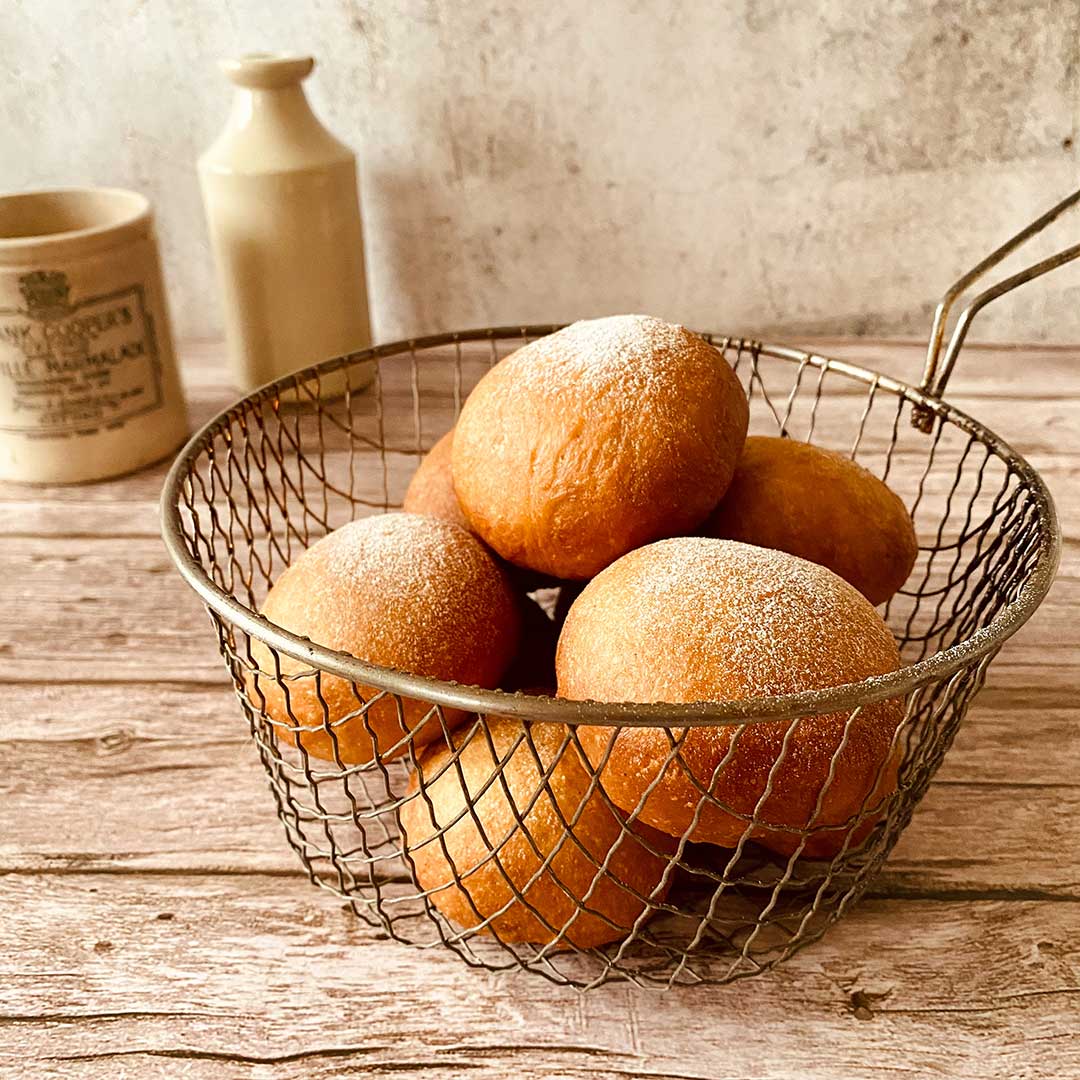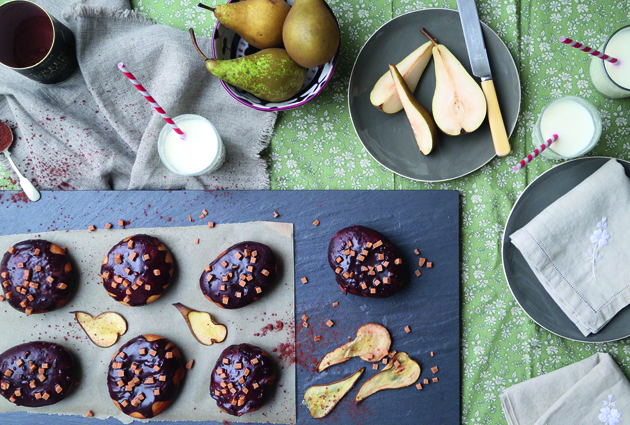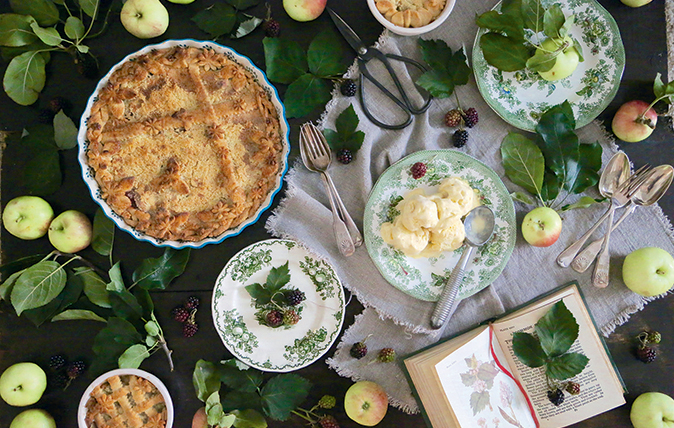How to make Isle of Wight doughnuts, the spiced plum treat unique to this corner of Britain
On the Isle of Wight, the humble doughnut takes a rather different — if no less delicious — form than it does in the rest of Britain. Author James Rayner explains more, and shares his recipe for this spicy plum treat.


Delicious dough, with the taste and texture of a spicy brown bread, and a rich, plummy filling — those are the key attributes of the Isle of Wight Doughnut, according to James Rayner. James is an author who grew up on the Isle of Wight and who published Historic Isle of Wight Food earlier this year.
He explains in the book how the doughnut evolved spontaneously on the Isle of Wight:
'Doughnuts (also simply called nuts) were made on the Island for many hundreds of years. Despite sharing a name with the American doughnut (which has Dutch origins), it seems that the Isle of Wight version developed completely independently from their Atlantic cousins, with some claiming that they can be traced as far back as the 17th century. One key difference with the Isle of Wight Doughnut is the filling — historically it would have been small, wild plums but sometimes currants were used instead.'An early recipe also includes an interesting combination of spices in the dough — allspice, cinnamon, cloves and mace. Some of these are grown in the Caribbean, while others are sourced from Asia but considering the importance of Cowes as an international shipping port and customs depot during the 18th and early 19th centuries, it’s not hard to see how Islanders could have got hold of these far-flung ingredients.'
James goes on to explain how the doughnuts were originally called birds' nests ('a name which came about from their appearance when cut in half with the cluster of plums in the middle') and how they were once well-known across Britain.
He also tackle the question of why plums became the filling of choice. The answer is to do with the fruit that grew naturally across the 150 square mile island during the 19th century, as James explains in his book:
'Wild plums and damsons grew abundantly throughout the Island... These fruits were mainly gathered and sold to make desserts, plums (locally called kix or kecksies) being used for cakes, puddings and Isle of Wight doughnuts, whilst damsons were used to make damson cheese — a preserve made from sugar and damsons, cooked together until they become the consistency of a soft cheese.'
Naturally, James also shares a recipe in his book for how to make Isle of Wight Doughnuts yourself, based on an original 1845 recipe. You can order his book online for £9.99 for this and more recipes from the island.
Recipe: Isle of Wight Doughnuts
Ingredients
Makes 10
- 300g strong white bread flour
- 150-175ml whole milk
- 50g unsalted butter, cubed
- 50g fine brown sugar or light muscovado, sieved
- 7g sachet of instant yeast
- 2 tsp allspice
- 1⁄4 tsp cinnamon
- pinch of ground cloves
- pinch of ground mace
- 1⁄2 tsp salt
- Vegetable oil for deep frying
- Small wild plums or piped plum jam, for the filling
Method
- Sift the flour and spices into a bowl, adding the salt and sugar on one side of the mixture and the yeast on the other. Add the softened butter and 120ml of the milk then combine by hand. Gradually add as much of the remaining milk as you need until the dough is soft and slightly tacky.
- Knead the dough on a flour dusted surface until smooth and no longer sticky. Oil the bowl, return the dough to it and cover, leaving it somewhere warm to rise until it has doubled in size.
- Line two metal baking trays with baking parchment. Place the dough back on a floured work surface and fold inwards until the air is knocked out and the dough is smooth. Divide into ten pieces and roll into balls.
- Make a hole in each ball of dough with the thumb and push or pipe a little of the filling inside. Stretch the dough over the hole to close it, pinching and twisting the join to seal it. Once filled, place the balls on the baking trays and cover for 45 minutes to double in size. They should ultimately be about the size of a cricket ball.
- Deep fry the balls, a few at a time for around seven minutes, until cooked through and a fine brown in colour. Turn them over half way through to ensure even colouring
- Remove the doughnuts from the pan with a slotted spoon, drain on kitchen paper and leave to cool.
Recipe and image from James Rayner, author of the new book ‘Historic Isle of Wight Food’, available online from wightoriginals.com and from retailers across the Isle of Wight.
Sign up for the Country Life Newsletter
Exquisite houses, the beauty of Nature, and how to get the most from your life, straight to your inbox.

Pear-and-chocolate doughnuts with fudge pieces
This recipe makes the lightest and fluffiest doughnuts that our kitchen garden cook has ever tasted.

Apple and blackberry crumble pie with amaretti ice cream
Apples are a firm British favourite and deservedly so.
Country Life is unlike any other magazine: the only glossy weekly on the newsstand and the only magazine that has been guest-edited by HRH The King not once, but twice. It is a celebration of modern rural life and all its diverse joys and pleasures — that was first published in Queen Victoria's Diamond Jubilee year. Our eclectic mixture of witty and informative content — from the most up-to-date property news and commentary and a coveted glimpse inside some of the UK's best houses and gardens, to gardening, the arts and interior design, written by experts in their field — still cannot be found in print or online, anywhere else.
-
 'The watch is Head Boy of men’s accessorising': Ginnie Chadwyck-Healey and Tom Chamberlin's Summer Season style secrets
'The watch is Head Boy of men’s accessorising': Ginnie Chadwyck-Healey and Tom Chamberlin's Summer Season style secretsWhen it comes to dressing for the Season, accessories will transform an outfit. Ginnie Chadwyck-Healey and Tom Chamberlin, both stylish summer-party veterans, offer some sage advice.
-
 Lewis Hamilton, Claude Monet and the Four Horsemen of the Apocalypse: Country Life Quiz of the Day, April 29, 2025
Lewis Hamilton, Claude Monet and the Four Horsemen of the Apocalypse: Country Life Quiz of the Day, April 29, 2025Tuesday's Quiz of the Day looks back at Lewis Hamilton's first win and ponders on the meaning of greige.